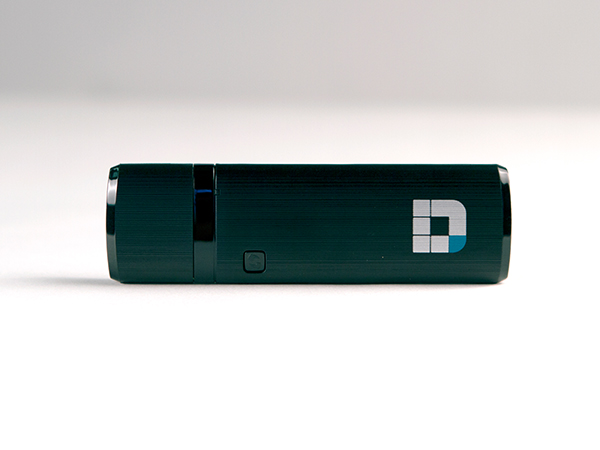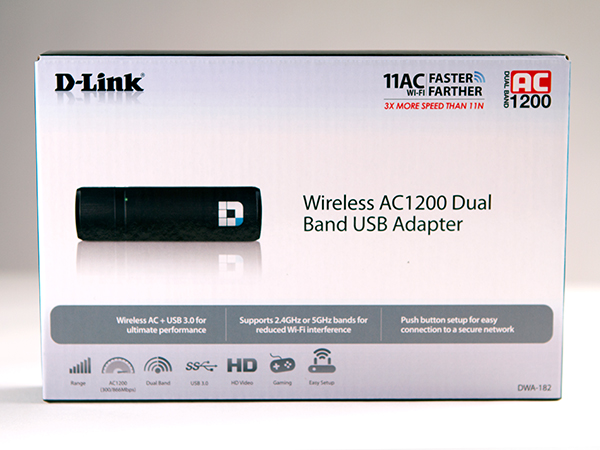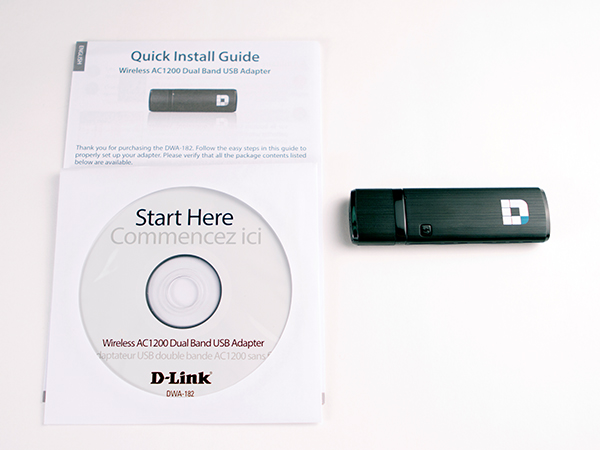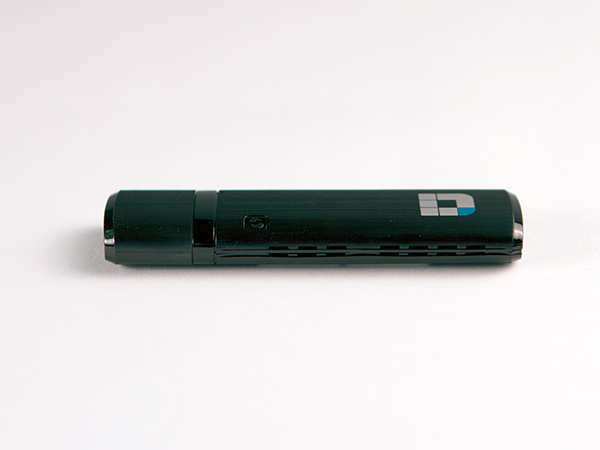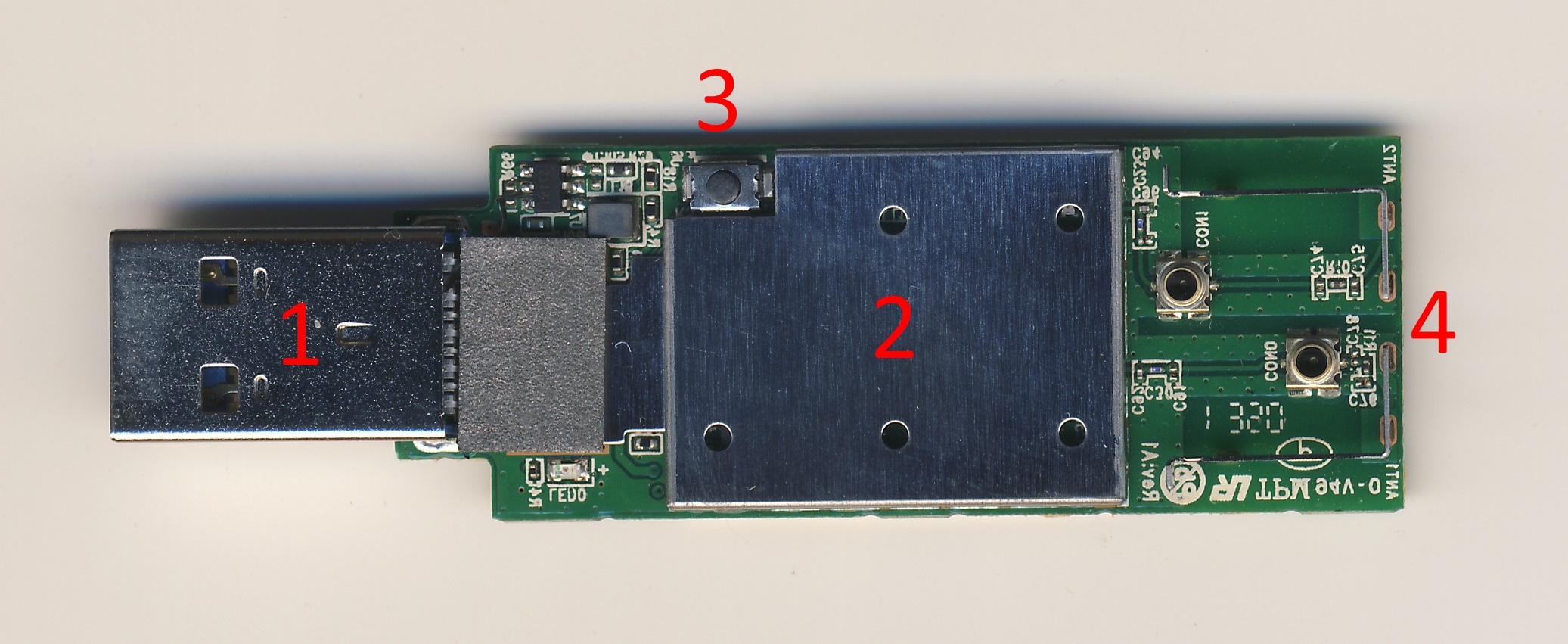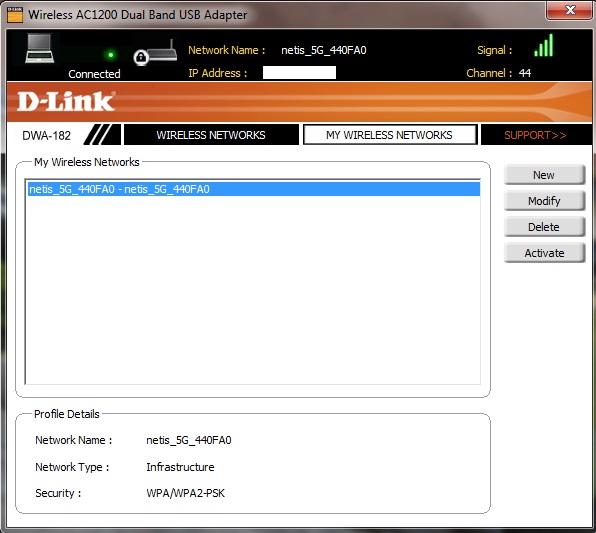AC1200 USB Wi-Fi Adapter Round-Up
Routers get all attention when it comes to Wi-Fi networking, but picking the right adapter is just as important. Today we test four 802.11ac USB adapters.
D-Link DWA-182
Why you can trust Tom's Hardware
D-Link was founded in 1986 and manufactures a variety of networking products, including routers, Wi-Fi adapters and even wireless security cameras.
While it DWA-182 does support the AC1200 standard, it's listed as "Draft AC" on D-Link's website, suggesting that it was not designed on the final 802.11ac standard. It takes a long time for the IEEE (Institute of Electrical and Electronics Engineers) to fully ratify a new wireless networking standard, so manufacturers sometimes release products based on the draft specifications.
I was nevertheless assured by D-Link's engineers that there were no changes from the draft to final release of 802.11ac that affected this adapter, and that its DWA-182 is fully 802.11ac-compliant. We'll see how it holds up against the rest of the field. D-Link's DWA-182 came out in the spring of 2013, so it is fairly old, after all.
Specs
- AC1200, up to 300 Mb/s on 2.4GHz and 867 Mb/s on 5GHz bands
- USB 3.0, backward-compatible with USB 2.0
- Broadcom controller
- Internal antenna
- OS support: Windows 8, 7, XP (SP3)
- 802.11ac (Draft), 802.11n, 802.11g, 802.11a
What's in the Box?
The following items are included in D-Link's packaging:
- DWA-182 Wi-Fi USB 3.0 adapter with protective cap
- Software CD
- Quick-start guide
Despite the DWA-182's age, we're fairly certain the hardware has undergone multiple updates. The version we're testing is labeled C1. According to D-Link's website, the A1 version was lighter at 16.7g, it came with a USB cradle, but was limited to the slower USB 2.0 interface and its 480 Mb/s transfer rate. C1 is slightly heavier at 20.5g, but benefits from USB 3.0 interface, capable of 5 Gb/s. That shifts the bottleneck over to to the Wi-Fi controller, rather than USB.
The DWA-182 has a WPS button and a single green status LED. Consider avoiding WPS for security. While the technology is convenient, there's an inherent risk to using it.
Finally, there is a user manual in PDF format on the CD, which is fairly typical these days as manufacturers move away from printed documentation.
Features
The D-Link DWA-182 features AC SmartBeam, which, rather than sending a signal omnidirectionally, works to send each device an individual signal to deliver the fastest connection possible. This is D-Link's implementation of beamforming, a technology designed for directional signal transmission, which uses an intelligent algorithm to detect where the device is and where it's going to send a focused, direct wireless signal.
AC SmartBeam is a proprietary chip-based (as opposed to antenna-based) implementation of beamforming that employs optimized drivers between a D-Link router and D-Link adapter. Of course, 802.11ac beamforming will work with this adapter and any other 802.11ac-capable router, but without AC SmartBeam's additional optimizations. AC SmartBeam only works on the 5GHz band, and only with D-Link's latest driver package. The company claims this technology increases throughput specifically in the middle of the adapter's range, but does not serve to increase range overall.
D-Link's bundled software found my home network and prompted me for my WPA2 password. It also revealed the Wi-Fi channels utilized by surrounding networks to suggest potential interference issues.
Standouts
D-Link's DWA-182, even more than the other USB-based Wi-Fi adapters, feels like a large flash drive. And not a high-end one, either. With its cap attached, the thin plastic device just doesn't exude quality.
General Observations
The DWA-182 has small slits on its sides for ventilation. They appear to be functional too, since the adapter didn't get hot through our testing.
1: USB 3.0 connector
2: RF shield
3: WPS button
4: Dual internal antenna
It's interesting that the DWA-182 employs two antennas internally, since multiple antennas are required for client-side beamforming (electronically focused communication back to the router).
Management
D-Link Wireless Connection Manager facilitates the DWA-182's connection to your wireless network. We used version 3.03.B04 for testing. If a network is not detected (should you choose not to broadcast your SSID, for instance), the software lets you manually configure the connection.
The software is stable and frankly easier to use than Microsoft's built-in configuration utility. More advanced options include security settings (WEP, WPA-Personal, WPA2-Personal, WPA-Enterprise, WPA2-Enterprise) and the ability to set up your network as infrastructure or ad hoc.
Availability, Warranty & Pricing
D-Link's DWA-182 has the most expensive list price of the adapters tested, at $75. It is available for less on Amazon, sporting a street price of $47.88. Warranty coverage lasts one year.
Get Tom's Hardware's best news and in-depth reviews, straight to your inbox.

Jonas P. DeMuro is a freelance reviewer covering wireless networking hardware.
-
SamSerious For notebooks these sticks look great, but as great as a flip-up antenna may be compared to the slim sticks, they will never be as good as those porducts where you can put a big omnidiretional antenna on. Therefore for users with bigger desktop computers, a PCIe adapter with multiple swapable antennas is still the way to go.Reply -
Math Geek did not take me long to realize that a usb stick on the back of a pc under a desk surrounded by a massive bundle of various cables was not the optimal way to go about wifi on a pc :)Reply
i always get the stick up in the air and away from the pc and easily see double the performance this way. can't tell you how many times i went to a client's house to see about wifi problems and fixed all the problems by simply putting the usb stick on an extension cable and taping it to the wall above the pc. BOOM instant signal and throughput gain.
as a result i look for internal cards with antennas on cables i can raise up or usb sticks that come with extension cables. just my personal experience anyway. -
gangrel Math Geek: yes! It applies to any kind of wireless. I like Logitech keyboard/mouse because the Microsoft transceivers have been far more problematic, and I greatly prefer wireless. Shifting that away from the chassis is helpful...and having it too near a WiFi antenna does increase problems.Reply
tb7: check the manufacturers' pages to see if they're showing Linux drivers, at least as a first step. Not, as I think you know, that this guarantees they'll work. But it'll be a heckuva lot faster for you to do the research, than to wait on the chance that someone here has done it. Better chance is to skip USB and go PCI; for whatever reason, PCI network cards install much more often, and more easily. -
Math Geek here's another thought since am actually in the middle of trying to figure this out. i wonder if the writer of this article knows a bit more about the features on these dongles?Reply
my lg phone is very easy to connect to my roku stick using the miracast feature. win 8.1 had this as a beta feature and i was able to use it on my laptop. win 10 has finished this feature and it is now built into windows. sadly, the finalized version does not work on my laptop like it did on win 8.1. best i can tell is that the wifi card is too old and does not support the finalized feature. i can get over that as the laptop is a few years old.
i would also like my desktop to connect the same way but my even older wifi dongle (n rated one) on my pc does not support it either. i can't find anything in any feature list for any brand wifi stick that says it supports the wifidirect standard that miracast uses.
does anyone know how/where it is listed or is it safe to assume it is there for any newer dongle i buy. i was going to try my luck and get a new ac model assuming it would be new enough to have it supported but would rather not play the guessing game with multiple models if it is not going to be universally supported. i can't find a list of supported hardware online nor any reference to wifidirect on any info sheet anywhere. :(
anyone know anything about this as it would be nice to wirelessly share my pc with my roku stick in another room. my phone does this no problem and it is a cheap model so this is not exactly a high end feature just one that lg supports very well.
note: wifidirect/miracast is not the same thing as the dlna that some other options use. i have no interest in buying a chromecast stick or anything else other than a new wifi stick. i want to use the roku stick i already have and use daily. :) -
gangrel Look here:Reply
https://www.wi-fi.org/product-finder-results?subcategories=23
Not many right now.
Readiing here:
http://www.broadcom.com/blog/home-entertainment/a-miracast-enabled-future-next-gen-screencasting-brings-your-content-to-life-video-demo/
the problem would appear to be, that router support is required, and may not be all that common. That suggests support in adapters will be slow. -
Math Geek Reply16724138 said:Look here:
https://www.wi-fi.org/product-finder-results?subcategories=23
i have been on that site and played with the search feature but was not able to get this subcategory. i only found a bunch of monitors and routers that worked :(
but hey thanks. now maybe i can finally figure out what i need to buy. book marking that search so i can find it again :D -
dstarr3 ReplyFor notebooks these sticks look great, but as great as a flip-up antenna may be compared to the slim sticks, they will never be as good as those porducts where you can put a big omnidiretional antenna on. Therefore for users with bigger desktop computers, a PCIe adapter with multiple swapable antennas is still the way to go.
Well, I'm building a mini-ITX build for the living room, and the only PCIe slot will be consumed by the GPU. There are motherboards with WiFi built in, but there are better boards that don't. So, this is a very good solution for those kinds of builds, as well. -
Math Geek Reply16724213 said:Math: check the Broadcom blurb I posted a bit late. :)
interesting article but that goes against what i thought wifidirect/miracast does. the feature uses the wifi cards in both devices to make a direct connection and pass data between them. a router should not come into play here. i think the article is saying the router will able to connect through miracast and then anything connected to the router will be able to use the data. at least this is how i read it :)
for instance just for giggles last time i was in sam's club i connected my phone to one of the lg tv's (miracast actually recognized about 10 different ones i could connect to) and mirrored my screen to the oohs and aaahhhhhs of the other shoppers who did not now they could do this. now this was done without any wifi connection at all. i was not on the store network and the tv was connected to none either. a couple other shoppers pulled out their phones and in a few minutes of showing them where the settings were, we had about 6 screen going with our phones mirrored.
this is why i read the article the way i do, since i know no actual wifi is needed, only compatible wifi cards. this is how it kills latency and such by being a direct connection between the devices with no middle man. it really is a neat feature and once it takes off, we'll all wonder how we lived without it. i watch movies from my phone to my tv all the time since it is easy to do and much easier than connecting my pc to my tv in the other room. hence my wish for a wifi dongle that works so i can do this from my pc and save my phone battery some :)
